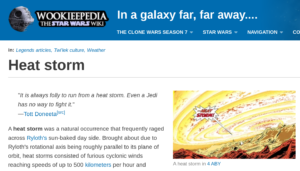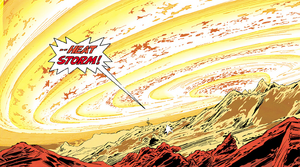The Los Angelos Times employed a new phrase designed to gin up climate fear among the public — the rise of the “heat storm.” LA Times staff writer Sammy Roth, used a term associated with the fictional Star Wars film series three times in his article titled “Boiling Point.” See: LA Times: Boiling Point: Climate change is wreaking havoc on the power grid in ways you never knew
LA Times Staff Writer Sammy Roth – ( [email protected] )
Roth reported, that “the state experienced hotter days and higher overall peak electricity demand during a July 2006 heat storm that did not lead to rolling blackouts.” In addition, Roth also cited the Sustainability officer for the Los Angeles Department of Water and Power as using the “heat storm” phrase as well.
The term “heat storm” is a relatively new term in the climate debate. Wikipedia defines a ‘heat storm’ this way: “A heat storm is a Californian term for an extended heat wave. Heat storms occur when the temperature reaches 100 °F (37.8 °C) for three or more consecutive days over a wide area (tens of thousands of square miles).”
Other news outlets have also sparingly used the term “heat storm” recently. See, here, here, here, and here.
Star Wars & ‘Heat Storms’
The term “heat storm” also derives from the Star Wars movie series. The website Starwars.fandom.com defines the fictional term “heat storm” as a “natural occurrence” that raged across the fictional planet Ryloth in the Star Wars film series. “Heat storms consisted of furious cyclonic winds reaching speeds of up to 500 kilometers per hour and temperatures upwards of 300 degrees Celsius” and “If anyone was caught in one, they would be incinerated.”
This sounds horrible for Californians! According to the Los Angeles Times, these (fictional) “heat storms” are now impacting California. The LA Times did not explain when people would be “incinerated” by these fictional Star Wars-inspired “heat storms.”
Full definition of the Star Wars fictional “heat storm” definition from Starwars.fandom.com is as follows:
“A heat storm was a natural occurrence that frequently raged across Ryloth’s sun-baked day side. [Note: “Ryloth was a planet in the Ryloth system of the Outer Rim Territories, and the homeworld of the Twi’lek species.”] Brought about due to Ryloth’s rotational axis being roughly parallel to its plane of orbit, heat storms consisted of furious cyclonic winds reaching speeds of up to 500 kilometers per hour and temperatures upwards of 300 degrees Celsius as they raged across Ryloth’s Bright Lands, searing everything in their path before eventually dying out on the planet’s night side. If anyone was caught in one, they would be incinerated.”
“It is always folly to run from a heat storm. Even a Jedi has no way to fight it.“―Tott Doneeta[src]
The question looms: Is LA Times staff writer Sammy Roth a news reporter or an aspiring Hollywood scriptwriter? In Roth’s LA Times bio, he brags that he is a climate activist who’s “focus” is on helping “reduce planet-warming emission more quickly.”
“For six years, I’ve focused on telling stories that challenge public officials and energy companies to reduce planet-warming emissions more quickly,” Roth explains. This isn’t just a job for me,” he wrote, adding, “Like many people, I want to contribute to a more sustainable future.”
Update: Meteorologist Anthony Watts comments: “It’s a ridiculous made-up term, because “storm” implies something active and moving. Heat waves just sit there. They are stagnant air by their very nature,” Watts wrote. “This renaming is just another way the left-leaning media wants us to be afraid of normal weather patterns by making it into something that sounds scarier than “heat wave,” Watts explained. “Don’t buy it, it’s bogus, aka ‘fake weather’ akin to ‘fake news,’ he added.
#
Excerpts of LA Times introducing the term “heat storms” in their October 15, 2020 article. See: LA Times: Boiling Point: Climate change is wreaking havoc on the power grid in ways you never knew
By Sammy Roth
There’s been a lot of debate about the extent to which climate change is actually to blame. Officials pointed out that four of California’s five hottest August days in the last 35 years came this past August; others have noted that the state experienced hotter days and higher overall peak electricity demand during a July 2006 heat storm that did not lead to rolling blackouts. …
The nonprofit research organization Climate Central analyzed federal data and released a report last month finding that hurricanes, wildfires, heat storms and other extreme weather events caused 67% more power outages in the United States during the decade ending in 2019 than they did during the previous decade. [Climate Depot note: Climate Central did not use the term “heat storm” in its report.]
…
“What happened during both of these heat storms was it didn’t cool down at night,” Nancy Sutley, chief sustainability officer for the Los Angeles Department of Water and Power, told me. “When it cools down at night — even when it’s really hot during the day — the equipment has a chance to cool down, and it will be OK. But the nighttime temperatures — when it was 111 downtown, it wasn’t 70 at night. It was 80 or 90 at night.”
End LA Times excerpt
#
Update: Meteorologist Anthony Watts Responds: You’ve heard of ‘fake news’? Now we have ‘fake weather’ – New scary (but bogus) weather term from the left-leaning media: “heat storm” comes from the Star Wars movie, but doesn’t happen on Earth
From Anthony:
Other than Star Wars, I have never heard the term applied in my over 30 years forecasting in California until today.
Wikipedia says (under the heat wave definition)
“A heat storm is a Californian term for an extended heat wave. Heat storms occur when the temperature reaches 100 °F (37.8 °C) for three or more consecutive days over a wide area (tens of thousands of square miles).”
I don’t know where this “definition” came from, and the Wikipedia article has no basis or citation/reference for it. Further, Googling the term brings up a brand of space heaters, and no actual usage of the term related to weather in the first two pages.
https://www.google.com/search?q=%22heat+storm%22&rlz=1C1GIGM_enUS835US835&oq=%22heat+storm%22
I did find one reference, and it appears this may be the very first use of the term:

Reading that article, suggests the term “heat storm” came from the imagination of the article writer. NOAA does not list the term “heat storm” in their official glossary.
https://w1.weather.gov/glossary/index.php?word=heat+storm
It’s a ridiculous made-up term, because “storm” implies something active and moving. Heat waves just sit there. They are stagnant air by their very nature. There’s even data and a map for it:
Stagnation When Heat Waves Exist – Summer, 1950-2007

NOAA DOES define “heat wave” as:
| Heat Wave A period of abnormally and uncomfortably hot and unusually humid weather. Typically a heat wave lasts two or more days. |
This renaming is just another way the left leaning media wants us to be afraid of normal weather patterns by making it into something that sounds scarier than “heat wave”.
Don’t buy it, it’s bogus, aka “fake weather” akin to “fake news”.
Related:
Warmists recycling ‘warmest year’ claims again for 2020 – Don’t be Conned







